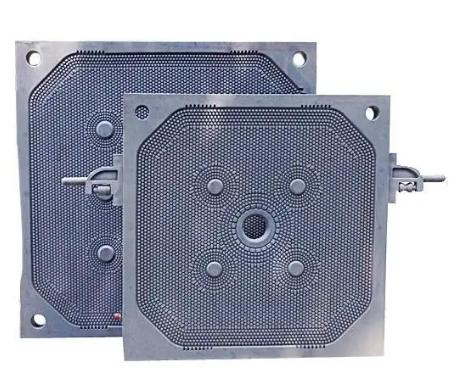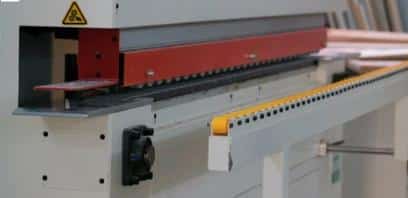Filter presses are an important piece of solid-liquid separation equipment used in a wide variety of industrial applications. Understanding how the capacity of a filter press is calculated is critical to properly selecting the equipment and optimizing the production process.
What is a filter press?
A filter press is a device that utilizes a filter medium to separate suspended solid particles from a liquid medium. The four main components of a filter press are the frame, the filter plates, the manifold (including piping and valves), and the filter cloth. The filter cloth in a filter press is a key component in optimizing the operation of the filter press. As the slurry is pushed into the filter press, the solids are uniformly dispersed in the filling cycle. Solid buildup occurs on the filter cloth and is called filter cake. The filtrate exits the filter press and enters the manifold through the corner opening. The filter press process happens to provide us with clean water.
Characteristics of filter presses
- High efficiency solid-liquid separation
- High production efficiency
- Applicable to different industries
- Stable and durable equipment structure
- Flexibility
Filter Press Chamber Capacity
The capacity of a filter press chamber is the total amount of solid-liquid mixture that a filter press chamber can hold under specific operating conditions. Filter presses typically contain one or more chambers, each used to load a solid-liquid mixture and perform pressure filtration. The capacity of the chambers depends on several factors, including the geometry and size of the chambers, the thickness of the filter cake, and the operating pressure.
Determine chamber geometry and dimensions: Determine the geometry (e.g., round, square, etc.) and dimensions (diameter, length, width, etc.) of the chamber based on the filter press design drawings or actual measurements.
Calculate the volume of the chamber: According to the determined geometry and dimensions, calculate the total volume of the chamber using the appropriate volume formula (e.g. cylindrical volume formula, rectangular volume formula, etc.).
Consider the thickness of the filter cake: When calculating the chamber volume, it is also necessary to consider the thickness of the filter cake. Cake thickness depends on factors such as filtration time, operating pressure, etc., and is usually determined experimentally or empirically.
Determine Operating Parameters: Chamber capacity calculations also require consideration of operating parameters such as filtration rate, operating pressure, etc. These parameters affect the solid-liquid mixture. These parameters affect the degree of compaction of the solid-liquid mixture within the chamber and the final cake thickness.
Calculate the actual capacity of the chamber: Taking the above factors into account, use the appropriate formula or method to calculate the actual capacity of the filter press chamber under specific operating conditions.
7 Key Options for Sizing A Filter Press
Filter Press Plate Design
Embedded Filter Plate
The recessed plates have a recessed surface within the perimeter area, eliminating the need for a frame, and the filter press plate is mounted directly to the plate surface. When a series of these plates are tightly packed together, voids are formed between them. A pump is used to force a mixture of solids and liquids to be sandwiched between the plates, where the solid material is captured in the recessed voids while the liquid passes through the cloth and is discharged through ports in the plate body.

Membrane Filter Press
Similar to the embedded plate, the membrane filter press has a recessed surface but is characterized by a flexible membrane covering the plate. This design allows the membrane plate to expand freely in the void space created between the plates, resulting in more thorough solid-liquid separation. By applying pressure, the flexible membrane of the membrane plates can change shape, further facilitating the solid-liquid separation and dewatering process.

Filter Press Plate Support Beam Design
Overhead Beam Design: The use of a design that supports the filter plate from the top helps to minimize dirt build-up and damage to the plate, ensuring the integrity and cleanliness of the filter cloth. The overhead beam design also optimizes maintenance and cleaning of the equipment, increasing its life and operating efficiency.
Side Beam Design: The filter plates are supported by long beams on the sides. Typically used for smaller size filter presses where space is limited. The side beam design has the advantage of simple construction and easy installation and maintenance, but may not be as convenient for cleaning and maintenance as the overhead beam design.

Filtered Water Discharge Options
Closed Filtration Drainage: Each corner of the filter plate has a small port through which the liquid drains out of the plate and is then directed through a pipe to a filtrate collection tank or other liquid collection device.
Open Filtered Water Discharge: Each filter plate has an internal port in the bottom corner through which liquid drains directly from the plate and can then be recycled into a collection tank or discharged into a waste liquid treatment system.
Filter Press Feed Pumps
The feed pumps for filter presses are usually centrifugal or positive displacement pumps. Centrifugal pumps generate centrifugal force by rotating to suck and press the slurry between the filter plates. Positive displacement pumps pump and discharge the slurry by varying the volume of the pump body. These pumps can be used individually or in series to produce different pressures and flow rates as needed to meet the processing requirements of the filter press.
Dual Feed And Core Blow Function
The dual feed function means that the filter press can simultaneously feed slurry from two directions to improve processing efficiency. The core blowing function, on the other hand, removes residual slurry from the filter cake by injecting compressed air or cleaning liquid at the end of the filter press, ensuring a dry and clean filter cake, reducing the need for cleaning and maintenance, and improving production efficiency.
Filter Cloth Cleaning And Drip Tray
Filter Cloth Cleaning: Filter cloth will accumulate solid particles and dirt during the filtration process, affecting the filtration effect. Cloth cleaning is usually done with high-pressure water or cleaning solution to remove dirt and solid particles from the surface of the cloth and restore its filtering performance.
Drip Tray: Drip trays can usually be raised and lowered to allow for easy discharge of effluent and cleaning solution during the cleaning process. Through the design of the drip tray, the wastewater generated during the cleaning process can be effectively collected and disposed of, keeping the working environment clean and tidy, and at the same time reducing the impact of wastewater on the environment.
Cake Dry and Cake Wash
- Cake drying: At the end of filtration, a certain amount of liquid may remain in the filter cake. To improve the dryness and solids content of the filter cake, cake drying is required. Usually compressed air or paddle dryer is used to dry the cake to remove the residual liquid in the cake, make the cake drier and improve the product quality.
- Cake Cleaning: In some applications, there may be some difficult to separate dissolved materials or dirt remaining in the filter cake, requiring cake cleaning treatment. Cake cleaning is usually done by injecting a clean liquid, such as water or chloramine or acetone, into the filter cake to clean the surface of the cake and remove the residual material.
Cake drying and cake cleaning are two important steps used in filter presses to process solid filter cake.
Summary
Understanding the role and impact of these key options is critical to the calculation and selection of a filter press to improve productivity and ensure the stability and reliability of the filter press over the long term.
KUOSI is always striving for excellence and offers its customers a range of excellent filter press products and professional technical support, including the conceptual screw press, low-temperature sludge dryer, dosing system, ozone generator, and wastewater screen for wastewater treatment to make your production process more efficient, stable and sustainable. Contact us for team support and solutions.
